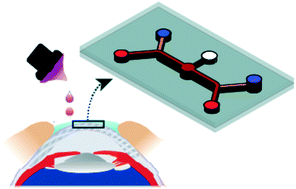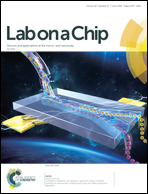A microengineered human corneal epithelium-on-a-chip for eye drops mass transport evaluation†
Abstract
Animals are commonly used for pharmacokinetic studies which are the most frequent events tested during ocular drug development and preclinical evaluation. Inaccuracy, cost, and ethical criticism in these tests have created a need to construct an in vitro model for studying corneal constraints. In this work, a porous membrane embedded microfluidic platform is fabricated that separates a chip into an apical and basal side. After functionalizing the membrane surface with fibronectin, the membrane's mechanical and surface properties are measured to ensure correct modeling of in vivo characteristics. Immortalized human corneal epithelial cells are cultured on the membrane to create a microengineered corneal epithelium-on-a-chip (cornea chip) that is validated with experiments designed to test the barrier properties of the human corneal epithelium construct using model drugs. A pulsatile flow model is used that closely mimics the ocular precorneal constraints and is reasonable for permeability analysis that models in vivo conditions. This model can be used for preclinical evaluations of potential therapeutic drugs and to mimic the environment of the human cornea.

- This article is part of the themed collection: Organ-, body- and disease-on-a-chip systems


 Please wait while we load your content...
Please wait while we load your content...